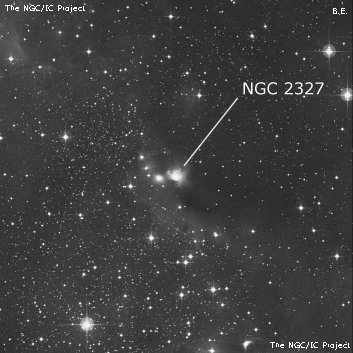
William Herschel discovered NGC 2327 = H IV-25 = h428 on 31 Jan 1785 (sweep 363) and described "A pretty considerable star with vF and vS milky chevelure of an irregular chevelure, other stars of the same size are perfectly free from that appearance." John Herschel reported on 11 Mar 1828 (sweep 130), "a double star whose large star is in the center of a very faint nebula which involves the small star also." His position of 07 04 07.6 -11 19.0 pins down the identification as a compact HII/Reflection nebula on the west side of the Seagull Nebula. In 1886, Engelhardt also published an accurate micrometric position of 07 04 07.77 -11 18 56.6 (J2000). Herbert Howe noted the central star is double with separation 7".
Joseph Turner (date uncertain) and Pietro Baracchi (11 Mar 1885) observed this nebula with the 48" Melbourne telescope. Turner's sketch was included in the unpublished plate V, figure 39).
Despite John Herschel's accurate position and description, there's been a great deal of confusion in the literature as to the identification and position.
300/350mm - 13.1" (12/22/84): fairly faint reflection nebula, fairly small, surrounds a mag 8 star (close unequal double). Located along the faint, extremely large, curving strip of nebulosity = IC 2177.
400/500mm - 17.5" (3/8/02): small but high surface brightness reflection nebula surrounding an unequal pair of mag 9.5/12.5 stars at 7" separation. At 280x, the nebulosity is round and approximately 50" in size although it fades smoothly into the background and may be a bit larger. This small knot of nebulosity is at the western end of a striking arc of 6 stars which trail off to the NE. The next star in the arc, 1.5' E, also seems to be encased in a very small halo. A similar mag 9.5 comparison star (with no halo) lies 4' ESE and several other mag 9.5-10.5 stars are scattered across the field. The background sky in this vicinity is weakly luminous, as NGC 2327 is situated midway along the western side of IC 2177, a huge IC strip of nebulosity straddling Canis Major and Monoceros. This object did not respond to OIII, UHC or H-beta filters so appears to be predominantly a reflection nebula.
This bright nebula was discovered by William Herschel (IV 25) in 1785 and reobserved by his son, John. Although their positions and descriptions match this object,there is a great deal of confusion in the literature as to its identification and position and some sources misidentify NGC 2327 with the much larger Sh 2-292 = Gum 1 located 50' to the north (also associated with IC 2177).
Notes by Steve Gottlieb